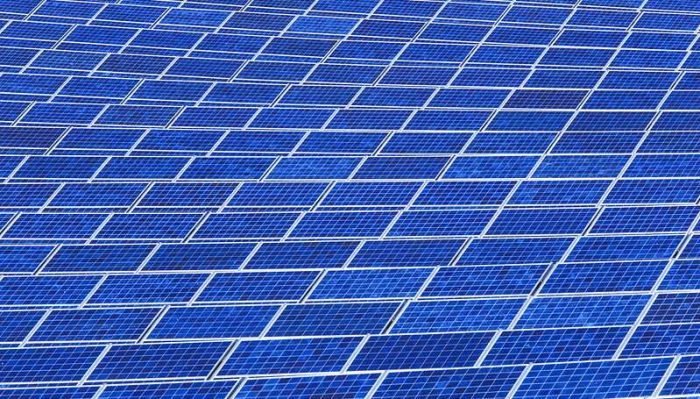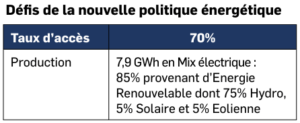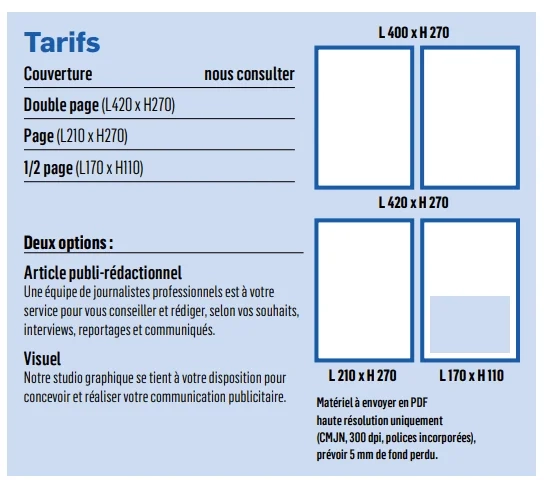Space not available
Reserve this advertising space
Selected ad format
The file format is not recognized
Click here for
upload an ad
Click here to download
an announcement
Here drag and drop or
upload an ad
Send the ad up to 8 days after payment
A link will be sent to you by contact@via-agency.media
Reserved space
Announcement transmitted
Reference

The electricity sector has been liberalized since 1999, promoting free competition for production and installing a regulator. The national rate of access to electricity is 15% and only 5,21% in rural areas. Support from the international community strengthens the sector's dynamics and secures investments.
Space not available
Reserve this advertising space
Selected ad format
The file format is not recognized
Click here for
upload an ad
Click here to download
an announcement
Here drag and drop or
upload an ad
Send the ad up to 8 days after payment
A link will be sent to you by contact@via-agency.media
Reserved space
Announcement transmitted
Reference
The Malagasy electricity mix is currently dominated by thermal energy sources (heavy fuel oil, diesel), whose prices are fluctuating and rising and whose consequences for the environment and health are harmful. Beyond an environmental and societal emergency, renewable energies are part of the country's development, through energy independence, cost control and the strengthening of the national economy.
A gigantic hydroelectric potential
The hydropower potential has been estimated at approximately 7.8 GW. Today, only 2% of this potential is exploited. More than 800 untapped hydropower sites with high potential have been identified, ranging from 10 kW to 600 MW located throughout the country. The World Bank, through the Energy Sector Management Assistance Program (ESMAP), is implementing technical assistance, which maps the potential for small hydropower projects (<20 MW). A study identified 2,045 small hydropower sites and prioritized 30 promising sites ranging from 1 to 20 MW. Two hydropower projects constitute a major asset for the development of the country's industrial and tourism activities:
The Volobe hydroelectric project includes, under a 35-year concession contract, the development, construction, and operation of a dam and a 120 MW hydroelectric plant on the Ivondro River, 40 kilometers west of Toamasina, Madagascar's second-largest city. The project also includes the transmission line, rehabilitation of the access road, and infrastructure for the surrounding villages. The partners have committed to co-developing the hydroelectric plant by acquiring an equity stake in the Compagnie Générale d'Hydroélectricité de Volobe (CGHV), which is leading the project and whose capital is shared between Jovena (40%), Africa50 (25%), SN Power (25%), and Colas (10%).
A government priority project, Volobe will provide access to reliable and affordable electricity to two million Malagasy people, contributing to the country's transition to renewable energy. The project will also reduce the current cost of electricity. The project will generate approximately 1,000 direct jobs during the construction phase. The plant is scheduled to be operational in 2023.
The dam will produce an average of 750 gigawatt hours (GWh) per year, or nearly 401 GWh of Madagascar's current electricity production. It will provide access to electricity for nearly 2 million people. The government's ambition is to provide electricity to almost all of Madagascar by providing clean, sustainable, and renewable energy.
About 100 kilometers from the capital, the Sahofika hydroelectric project has received financial support from the AfDB. The African Development Fund (ADF) has granted EUR 4.02 million to the Malagasy government for its stake in this renewable energy project. Sahofika, located 100 km southeast of Antananarivo on the Onive River, will inject 205 MW into the Jirama network and will be able to supply 8 million Malagasy people. Developed as part of a public-private partnership (PPP), the New Hydroelectric Energy of the Onive (Neho) consortium is made up of the French company Eiffage, the Moroccan company Themis, and Eranove, a Franco-African company. The goal is to inject 200 MW into Madagascar's electricity grid through the construction of a dam on the Onive River. The dam will be 60 meters high with a reservoir that will cover an area of 6.7 km2. A Resettlement Action Plan (RAP) has been developed by Neho to address population displacement in accordance with Malagasy legal requirements and international standards, particularly those of the AfDB and the International Finance Corporation (IFC).
The Sahofika hydroelectric power plant, which will be operational in 2024, will also allow for the rehabilitation of 110 km of access roads and the construction of a 75 km long 220 KV transmission line. The 205 MW injected into the network of the state-owned company JIRAMA will be able to supply 8 million Malagasy people while avoiding 900,000 tonnes of CO2 emissions per year. This is the largest hydroelectric project under development in the country, making it possible to diversify its electricity mix in favor of renewable energies, at 90%.
Space not available
Reserve this advertising space
Selected ad format
The file format is not recognized
Click here for
upload an ad
Click here to download
an announcement
Here drag and drop or
upload an ad
Send the ad up to 8 days after payment
A link will be sent to you by contact@via-agency.media
Reserved space
Announcement transmitted
Reference
An exemplary solar resource, photovoltaic power plants
Almost all regions of Madagascar receive more than 2,800 hours of sunshine per year. Average annual production amounts to 1,600 kWh/kWp. Maximum potentials are among the highest in the world, and minimum potentials are on average 3 to 4 times higher than those in Western Europe. At the end of 2019, the Ministry signed a memorandum of understanding with JIRAMA and Green Energy Solutions (GES), setting out the new contractual and pricing conditions for hybridization contracts in the cities of Morondava, Sambava, Antalaha, and Vohemar.
The implementation of hybrid solutions is part of the new national energy policy which aims to modernize existing thermal power plants and participate in the JIRAMA recovery plan with the support of various donors including the World Bank and the European Union.
In Ambatolampy, covering an area of 33 hectares, 73,008 solar panels make up the largest photovoltaic power plant in the Indian Ocean. With a capacity of 20 megawatts, this solar power plant will cover the annual electricity needs of nearly 50,000 households in Antananarivo and Antsirabe. It will meet the growing energy demand linked to the economic and industrial development of the Vakinankaratra region. The installation of this photovoltaic power plant is in line with Malagasy energy policy and is one of the objectives set at COP 21 in Paris. Madagascar will thus save up to 25,000 tons of carbon dioxide per year.
The project was launched thanks to cooperation between the company Green Yellow and the Malagasy government, with an investment of 25 million Euros.
To support the financing of this large solar power plant, GreenYellow, Axian, Société Générale, GuarantCo, and African Guarantee Fund closed a EUR 16.2 million transaction in October 2020 to accelerate the country's energy transition. In structuring this transaction, Axian acquired 51% of the solar power plant's shares in June 2020. Société Générale, acting as exclusive arranger and co-lender with BNI and BMOI, lent EUR 16.2 million. GuarantCo and African Guarantee Fund provided additional support with guarantees of USD 9.3 million and USD 3.8 million, respectively.
The Tsaratanana agro-photovoltaic power plant project, implemented by Sun Farming, aims to produce 25 MW of solar energy by 2021. The goal is to improve electricity supply to several districts in the Vakinankaratra region, including Faratsiho and Antanifotsy. Financed by the German Federal Bank as part of the general policy of prioritizing access to drinking water and electricity, it also includes an agricultural component that will allow the establishment of an agricultural and livestock training center and hydroponic cultivation infrastructure. In total, 20 food and energy training centers of 20 MWP will supply the territory with training places and green electricity on 40 hectares of land.
The technology chosen for Morondava will partly use the sun to produce electricity via the solar power plant during the day, from 7 a.m. to 5 p.m., while thermal generators will take over in the evening or in the event of a power drop. Morondava's solar hybrid system is expected to produce 5 MW of solar electricity. The investment cost of the hybridization operation is estimated at 5 M$. GES (Green Energy Solution) is providing the engineering work for Jovena-Jirama, the project developers. The first phase of the city's hybridization, completed in 2019, provides 4 MWp of solar and 4 MWh of battery storage. A hybrid solar power plant from Mada Green Power will be installed in 2021 in Andranotakatra, in the Mahajanga district. It is expected to produce up to 17 MW of energy.
Similarly, Oursun Green Power also announced the installation of three photovoltaic power plants on the roofs of buildings in the capital. With a combined capacity of 11 MW, these infrastructures will improve the energy available on Antananarivo's interconnected grid. With rooftop technology, these plants will optimize the available space in the capital. The installation of these plants will improve the supply of Antananarivo's interconnected grid. The use of renewable energy is a key component of JIRAMA's recovery strategy, whose financial resources are heavily burdened by the purchase of fuel for its thermal power plants.
Untapped wind potential
With a lifespan of approximately twenty years, wind turbines can meet power needs. This solution is modular: depending on the evolution of local electricity demand, new turbines can be installed. Madagascar's wind potential is concentrated in coastal areas. The northern part around Antsiranana and the southern part around Taolagnaro have wind speeds of 3 to 8 m/s to 20 m/s, with a potential capacity of approximately 2,000 MW for electricity production. There is a high demand for hybridization with other technologies for commercial uses.
Two rural communes, Andiolava and Satrokala, located in the Ihosy district, are electrified using renewable energy, particularly wind power. Aside from energy production, a large-scale farm is also powered: it covers an area of approximately 4,000 hectares on the Ihorombe plateau. A hybrid wind-solar system has been set up for this purpose, consisting of wind farm installations in the rural commune of Satrokala, capable of supplying 60 kilowatt-hours of electrical power, as well as solar modules for the rural commune of Andiolava.
Biomass, an energy of the future
Madagascar has significant biomass resources that could be used as fuel to generate electricity by installing decentralized electrification networks. This electricity production, ten times cheaper than that of diesel-powered generators, would allow for the development of downstream economic activities, such as hulling and small-scale crafts, but also upstream, to ensure the management of the biomass, its exploitation and its transport to the production site.
Indeed, more than 80% of the Malagasy population earns its living from agriculture, a sector producing a lot of unexploited plant waste. Agricultural biomass resources could fuel electricity production in some urban and rural areas. Similarly, replacing traditional carbonization mills with high-efficiency equipment would allow charcoal producers to significantly improve their production yields without additional investment.
 Accompanied by an efficient collection system, biomass electricity generation technology represents a significant economic and ecological opportunity, particularly for rural areas. The potential varies, depending on the site and raw materials, from a few kW to more than 150 MW.
Accompanied by an efficient collection system, biomass electricity generation technology represents a significant economic and ecological opportunity, particularly for rural areas. The potential varies, depending on the site and raw materials, from a few kW to more than 150 MW.
Boosting investment in renewable energy
Using EDF resources, the ENERGIES program provides financial and technical support to concrete, tailored, innovative, and sustainable projects to meet the energy needs of communities. Thirteen projects have been launched, of which eleven have been completed and two are currently being finalized. The financial support, amounting to EUR 3.4 million, has made it possible to mobilize at least the same amount of investment. Nine Malagasy projects have been selected.
Space not available
Reserve this advertising space
Selected ad format
The file format is not recognized
Click here for
upload an ad
Click here to download
an announcement
Here drag and drop or
upload an ad
Send the ad up to 8 days after payment
A link will be sent to you by contact@via-agency.media
Reserved space
Announcement transmitted
Reference



















 A Seat That Transforms into a Bed
A Seat That Transforms into a Bed  In the world of air travel, economy class is often considered the most affordable option. However, at Air Afrika, we believe that affordability shouldn't mean compromising on quality of service. Our class
In the world of air travel, economy class is often considered the most affordable option. However, at Air Afrika, we believe that affordability shouldn't mean compromising on quality of service. Our class









